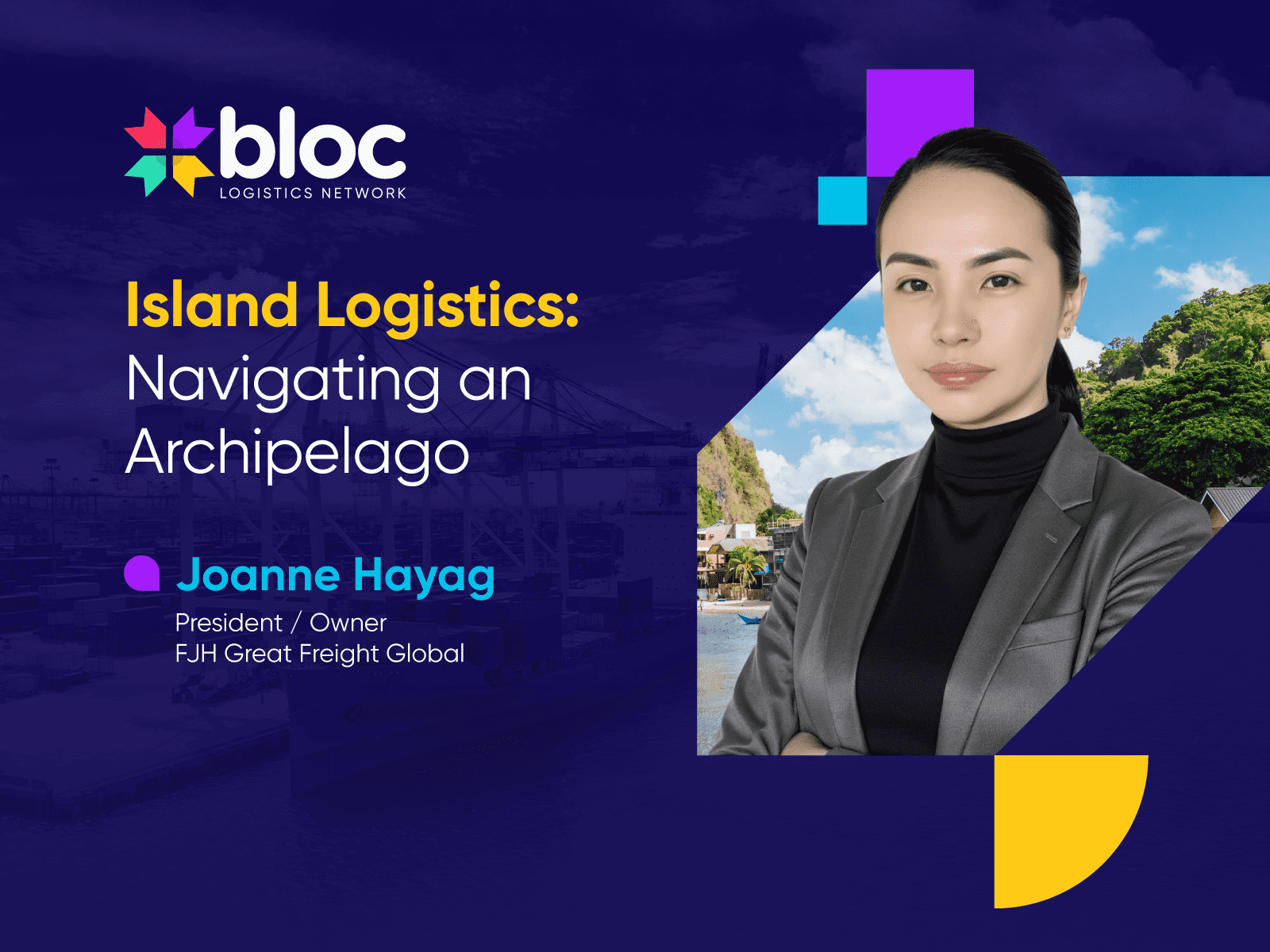By: Joanne Hayag, President of FJH Greatfreight Global Logistics Inc. in the Philippines
The Philippines presents unique logistical challenges that distinguish it from continental markets. With 7,641 islands scattered across 1,500 miles of ocean, the country demands specialized approaches to freight forwarding and supply chain management. Philippine archipelago logistics requires understanding both traditional shipping methods and modern technological solutions.

The fragmented geography creates operational complexities that affect cost structures, transit times, and service reliability. Each island connection represents a potential bottleneck, requiring careful coordination between multiple transportation modes. This geographical reality shapes every aspect of logistics operations, from warehousing strategies to last-mile delivery solutions.
Modern freight forwarders operating in this market must balance efficiency with reliability. The interconnected nature of island logistics means disruptions in one area cascade throughout the network. Weather patterns, port capacity limitations, and infrastructure variations between islands compound these challenges.
Digital transformation has emerged as a critical tool for managing archipelago logistics. Real-time tracking systems provide visibility across island networks, while predictive analytics help anticipate potential disruptions. These technological solutions enable proactive management of complex supply chains.
Digital Solutions Transforming Philippines Archipelago Logistics
Technology integration has revolutionized how logistics companies approach island-to-island transportation. Cloud-based platforms now connect disparate shipping networks, creating unified visibility across the archipelago. This connectivity allows for better coordination between sea, air, and land transportation modes.
Automated documentation systems reduce processing delays at multiple checkpoints. Electronic manifests speed customs clearance, while digital bills of lading minimize paperwork handling across island transfers. These systems particularly benefit time-sensitive shipments moving through multiple jurisdictions.
Mobile applications have transformed communication between drivers, port operators, and logistics coordinators. Real-time updates about vessel schedules, port congestion, and weather conditions enable rapid response to changing circumstances. This immediate information flow helps maintain service levels despite geographical constraints.
Data analytics platforms analyze historical shipping patterns to identify optimal routing strategies. Machine learning algorithms consider seasonal variations, port capacity, and vessel availability to recommend efficient pathways through the island network. These insights reduce both costs and transit times for regular shipments.
Port Development Initiatives Improving Philippines Archipelago Logistics
Strategic port investments have begun addressing infrastructure gaps throughout the island chain. New deep-water facilities in secondary islands reduce dependence on major hub ports like Manila and Cebu. This distributed capacity helps balance traffic flows and creates alternative routing options.
Container handling capabilities have expanded significantly in regional ports. Modern crane systems and storage facilities enable larger vessels to service previously underserved islands. These improvements reduce transshipment requirements and associated delays.
Intermodal connectivity has improved through coordinated port and highway development projects. Better road connections between ports and inland destinations reduce dwell times and improve overall supply chain efficiency. These infrastructure investments particularly benefit manufacturing and agricultural export operations.
Private sector partnerships have accelerated port modernization efforts. Joint ventures between international operators and local companies bring expertise while ensuring local market knowledge. These collaborations often result in more efficient operations and improved service standards.
Network Global Logistics Strategies for Island Operations
Successful archipelago operations require network global logistics thinking applied to local conditions. Hub-and-spoke models work effectively when properly adapted to island geography. Strategic positioning of consolidation centers reduces empty vessel movements and improves load factors.
Flexible vessel scheduling accommodates varying demand patterns across different islands. Smaller, more frequent services often prove more efficient than large, infrequent shipments. This approach reduces inventory holding costs while maintaining service reliability.
Cross-docking facilities positioned at strategic locations minimize storage requirements and speed cargo flows. These facilities enable rapid transfer between different vessel types and sizes, optimizing the transportation mix for each leg of the journey.
Regional partnerships between freight forwarders create comprehensive coverage without requiring individual companies to maintain offices on every island. Shared resources and local expertise improve service quality while managing operational costs.
Weather and Seasonal Considerations in Philippines Archipelago Logistics
Typhoon seasons significantly impact logistics planning throughout the archipelago. Operations must build flexibility into schedules to accommodate weather-related delays and route diversions. Advanced weather monitoring systems help predict and prepare for disruptions.
Monsoon patterns affect vessel operations differently across the island chain. Northern regions experience peak disruptions during different months than southern areas. This seasonal variation requires dynamic planning approaches that adjust capacity allocation throughout the year.
Emergency response protocols become critical during severe weather events. Contingency plans must account for potential isolation of specific islands and alternative supply routes. Pre-positioned inventory and flexible transportation arrangements help maintain service continuity.
Insurance considerations reflect the increased risks associated with archipelago operations. Comprehensive coverage must account for weather-related delays, transshipment risks, and potential cargo damage during multiple handling operations.
Technology Integration Challenges in Philippines Archipelago Logistics
Internet connectivity varies significantly between islands, affecting digital solution implementation. Robust systems must function reliably despite intermittent connections and varying bandwidth availability. Offline capabilities become crucial for maintaining operations during connectivity issues.
Integration between different technology platforms presents ongoing challenges. Multiple shipping lines, port operators, and government agencies often use incompatible systems. Standardization efforts progress slowly but remain necessary for seamless information flow.
Training requirements increase with technology adoption across diverse locations. Remote islands may lack technical support infrastructure, requiring self-sufficient systems and comprehensive user training programs. This human factor often determines technology implementation success.
Cost-benefit analysis must consider the full archipelago network when evaluating technology investments. Solutions that prove effective in major ports may not justify costs in smaller island operations. Scalable platforms that adjust functionality based on location requirements provide better value.
Infrastructure Development Supporting Modern Logistics
Road network improvements on major islands enhance last-mile delivery capabilities. Better connections between ports and inland areas reduce transportation costs and improve service reliability. These infrastructure investments benefit both domestic and international shipments.
Airport cargo facilities have expanded to support time-sensitive shipments between islands. Air cargo becomes cost-effective for high-value, low-weight items when sea transportation faces delays. Improved airport infrastructure provides valuable alternatives to sea-only logistics chains.
Communication infrastructure development supports advanced logistics operations. Fiber optic cables between islands enable real-time data exchange and system integration. This connectivity foundation makes sophisticated logistics technologies practical across the archipelago.
Power infrastructure reliability affects warehouse and port operations throughout the island chain. Backup power systems and renewable energy installations reduce operational disruptions. Reliable electricity supply becomes particularly important for refrigerated cargo handling facilities.
Economic Impact of Improved Philippines Archipelago Logistics
Reduced transportation costs benefit both exporters and importers across the island chain. Improved logistics efficiency translates directly into better competitiveness for Philippine products in global markets. Manufacturing operations become more viable in previously underserved islands.
Tourism development benefits from reliable logistics networks that ensure consistent supply of goods and services. Improved connectivity between islands supports both domestic and international tourism growth. Hotels, restaurants, and tour operators depend on efficient supply chains.
Agricultural exports gain market access through improved cold chain logistics. Perishable products from remote islands can reach international markets more reliably. This improved connectivity supports rural economic development and reduces urban migration pressures.
Small business development accelerates with better logistics infrastructure. E-commerce becomes viable for businesses in remote locations when reliable shipping services exist. This connectivity expansion creates new economic opportunities across the archipelago.
Philippines Archipelago Logistics, Challenges and Growth
The Philippines’ complex island geography continues to present unique challenges for logistics professionals. However, ongoing investments in digital technology, port infrastructure, and network optimization are creating new opportunities. Success in this market requires understanding both traditional shipping methods and modern technological solutions.
FJH Greatfreight Global Logistics Inc., as a member of the Bloc Logistics Network, leverages both local expertise and global connections to address these archipelago challenges. The collaborative approach of network global logistics proves particularly valuable in managing the complexities of inter-island transportation while maintaining service quality and cost efficiency.

Article by Joanne Hayag, LCB
President / Owner, FJH Greatfreight Global Logistics Inc., a member of Bloc Logistics Network
FJH Greatfreight Global Logistics Inc. , based in Parañaque City, Philippines, is a specialized logistics provider known for its expertise in Customs Brokerage and International Freight Forwarding, led by a team of licensed customs brokers. The company offers a wide range of services including air, sea, and ground freight, warehousing, 5PL, project cargo handling, and e-commerce fulfillment. With a focus on reliability and cost-efficiency, Greatfreight also provides on-board courier services, customs accreditation, and cargo insurance to support clients in a dynamic logistics landscape.
Bloc Logistics Network is a global platform that connects logistics professionals to share opportunities and collaborate without barriers. Bloc aims to level the playing field by creating an accessible, supportive environment where professionalism and collaboration drive real results. It serves as an ecosystem designed for mutual advancement, ensuring growth, efficiency, and success across the logistics industry.





